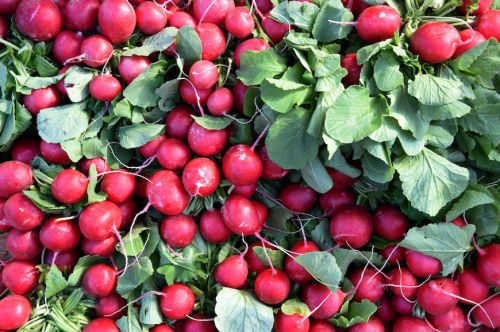Our editors independently select these products. Making a purchase through our links may earn Well+Good a commission
Let me start by saying that this is probably the most sex-positive story about food waste you’ll ever read. Not a high bar there, admittedly, but fair warning: There will be TMI. Because radish greens are a full-body experience.
Yes, I’m talking about the leaves you probably toss in the trash before slicing into the bright red bulbs. But here’s the thing: As delicious and nutritious as radishes are, you’re missing the healthy boat if you ignore their greens. Eating sauteed radish greens (or, if I’m feeling lazy, using the leaves to brew a quick tea) is the most effective way I’ve found to get my skin, my gut health, and (here comes the TMI) my vaginal situation back in perfect balance.
I discovered this a few months ago when a veggie-savvy friend made some radish greens tea for me when I had a stomachache and felt generally off—like, either I’d eaten some bad takeout or a full-blown flu was on the way. After drinking the peppery, earthy-tasting tea (consider it a medicinal sip, not a culinary experience), I was feeling better within a couple of hours.
Eating sauteed radish greens (or, if I’m feeling lazy, using the leaves to brew a quick tea) is the most effective way I’ve found to get my skin, my gut health, and my vaginal situation back in perfect balance.
Then, when I looked in the mirror I noticed that not only had the unmistakable “I’m sick” look (greenish tint, dark under-eye circles) disappeared from my face, I swear my pores had also shrunk in the process. And the skin on my chest—which I’ve come to use as a barometer for my wellness level—was smoother and softer than it had been in months.
Fantastic! But the most surprising thing was that I was also completely rid of the not-quite-there yeast infection that had been threatening my genital life for days. Every morning, I’d wake up wondering if I’d nipped it in the bud—and a couple of days of good results would inevitably be followed by a (pretty inflamed) setback. I never knew what to expect, and it seemed like I couldn’t keep the down-there diva happy no matter what I did.
Post-radish greens, everything was…how can I say this? Perfect. The candida symptoms had vanished. And though I wasn’t in the ovulation week of my menstrual cycle, the texture of everything was like a lighter version of the super-slick, eggwhite-y feel you get during the ovulatory phase. I was bursting with vag pride, I’m not ashamed to say—she and I were in full lovefest mode, completely in sync.

Ever since, I keep thinking: Why isn’t everyone talking about radish greens? They’re not yet on the veggie A-list, like cauliflower—being talked about at dinner parties and the subject of endless food-industry brainstorms (oh hi, cauli tots!). Yes, in-the-know healthy cooks use them—and they’ve even gotten shout-outs on hit shows like Iron Chef—but they’re hardly a household name.
At least, that’s true in the West. Radish greens—which are rich in vitamin C, vitamin B6, magnesium, phosphorus, iron, calcium, vitamin A, potassium, and folic acid—have long been used in traditional Ayurvedic cooking from India. They’re brewed in teas or added to sautés—and believed to purify the blood, cleanse the liver, and flush out stored toxins (known as ama), says Ayurvedic nutritionist Sahara Rose Ketabi.
“Radish greens are unlike other greens because of their pungent qualities, which enhance the digestive fire, or agni,” says Ketabi, author of the cookbook Eat Feel Fresh and the Idiot’s Guides book Ayurveda (with a foreword from Ayurveda OG Deepak Chopra, MD).
According to Ayurveda, “heating” foods speed up digestion and “cooling” foods slow things down and calm inflammation. Ketabi explains that radish greens have an unusual balance of hot and cold. “Most greens are cooling for the digestion, but radish’s pungency enhances [the fiery energy known as] pitta in the digestion, while still cooling the blood,” she says. This means you get the metabolic rev-up without creating other inflammation (like breakouts and skin rashes) that, according to Ayurveda, result when blood “heats up.”
I keep thinking: Why isn’t everyone talking about radish greens? Yes, in-the-know healthy cooks use them—and they’ve even gotten shout-outs on hit shows like Iron Chef—but they’re hardly a household name.
So, how did they work their candida-busting magic on my body? It’s all about that fired-up digestive engine, Ketabi says.
“Yeast infections are caused from too much ama, or toxins, in the system, which is often the result of a sluggish digestion. Increasing the pitta in your digestion will make it more efficient, allowing your body to properly break down foods and get rid of the rest, preventing candida overgrowth,” she says.
In the months since my radish-related epiphany, I’ve observed that these greens have a real knack for making whatever’s wrong in my body right again, gastrointestinally speaking. They are not a cure-all, of course. But when something feels off, the first thing I do is hit the market to get the greenest, cleanest, most unblemished radish leaves I can find. (Look for bunches with no breaks or wilting to get the most powerful plant punch.) Yes, they don’t have the buzz of wellness-world feel-better favorites like adaptogens, activated charcoal, or apple cider vinegar. But these unsung greens are a gift you’ve been tossing in the trash for years.
Here’s another way to get more greens, glorious greens, into your life—and here’s our guide to shopping for and cooking the nutrient-dense veggies.
Sign Up for Our Daily Newsletter
Get all the latest in wellness, trends, food, fitness, beauty, and more delivered right to your inbox.
Got it, you've been added to our email list.











